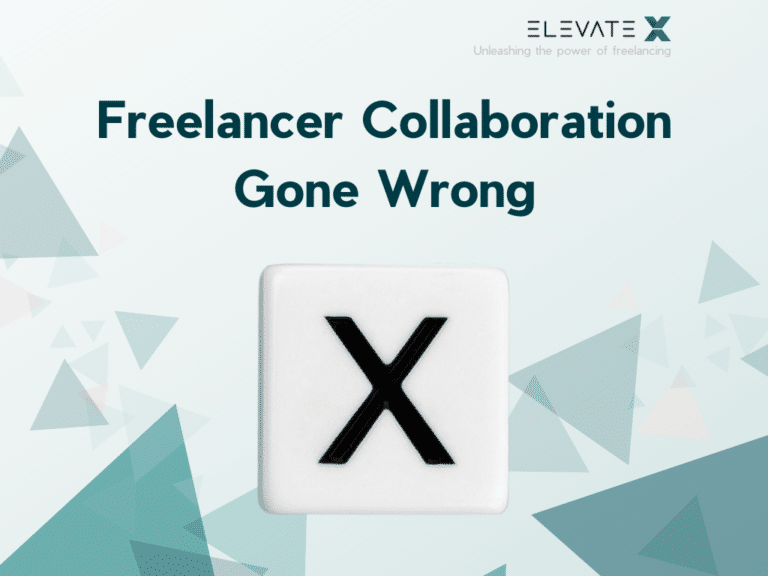Collaboration between companies and freelancers can be challenging, and misunderstandings or problems can arise for various reasons. But don’t panic! Here, you’ll learn what to do when working with freelancers doesn’t go as planned.
Introduction
Collaborating with freelancers can be challenging. It’s common to hear about projects that don’t go according to plan. But why is that? A common reason is simply communication. Freelancers and companies often operate in different worlds. Freelancers work independently and flexibly, while companies have clear structures and processes. Bridging these two realities can lead to friction.
Another problem area is expectations. Companies often have clear ideas about what they need, but these aren’t always communicated transparently. If the freelancer has a different understanding, it can lead to a clash of worlds that are hard to harmonize. Deadlines also play a role. A project can stall if milestones aren’t met, leading to frustration on both sides and further straining the collaboration.
Why is it still so important to have successful collaboration with freelancers? Flexibility and specific expertise are just a few of the benefits freelancers bring. They can enrich projects by introducing fresh perspectives and innovative ideas. In an increasingly dynamic work environment, being able to respond flexibly to market demands is essential. Successful collaboration allows you to leverage these advantages and combine the best of both worlds. Therefore, it’s worth identifying and addressing potential pitfalls early on.
KEY POINTS
- Misunderstandings in collaboration with freelancers often arise from unclear or irregular communication.
- Companies and freelancers need to set realistic and transparent goals together to avoid dissatisfaction.
- Unexpected complications can occur, so timelines should be adjusted if necessary to ensure the quality of the work.
- A detailed briefing lays the foundation for a shared understanding and minimizes misunderstandings.
Common Problems and Their Causes
While working with freelancers offers many benefits, it also comes with challenges. Communication is a major problem area. Misunderstandings often arise because communication isn’t clear or frequent enough. A short briefing here, a quick email there—this isn’t enough. Without clear and detailed agreements, both the freelancer and the company risk having different expectations.
Speaking of expectations, these are often another stumbling block. Companies sometimes expect a magical solution overnight, while the freelancer works independently with limited insight into the company’s internal processes. This discrepancy often leads to dissatisfaction on both sides. Unrealistic timelines or unclear goals further exacerbate the issue.
Deadlines are also a significant problem. Freelancers often work on multiple projects simultaneously. If priorities aren’t clearly set or unexpected complications arise, time constraints can quickly become a burden. This often leads to delayed deliveries and disappointed expectations.
Quality is another critical issue. If the delivered results don’t meet the company’s expectations, frustration and dissatisfaction arise. Often, the problem isn’t the freelancer’s skills but unclear requirements. A lack of specific briefing leaves the freelancer in the dark, unable to deliver what’s truly needed.
Overall, communication, expectations, deadlines, and quality are the central problem areas to be aware of. Without clear rules and agreements, trouble is inevitable.
Immediate Actions: First Steps When Problems Arise
As soon as the first signs of trouble in collaborating with freelancers appear, quick action is required. The first and most important step is open communication. Sit down with the freelancer and clearly address the existing problems. Often, misunderstandings or uncertainties are the root cause.
By directly addressing the issue, you can clear up misunderstandings and work together on a solution.
Expectations may also need to be adjusted. Agree together on what goals are realistic and how they can be achieved. Clear and realistic expectations on both sides are the key to successful collaboration. If the originally set goals are no longer attainable, it’s better to adjust them in time rather than end up completely dissatisfied.
Flexible deadlines can also help resolve issues. While agreed-upon deadlines should be met, sometimes unforeseen circumstances simply cannot be avoided. Discuss together whether and how timelines can be adjusted without compromising the quality of work.
Ideally, these first steps can clarify and improve a lot, so the collaboration can proceed smoothly and productively again.

Tips for Avoiding Future Problems
To ensure smooth collaboration with freelancers, clear briefings are essential. A well-structured and detailed briefing lays the foundation for mutual understanding. It should include all important information, from the project goal and requirements to the desired outcomes. A complete briefing minimizes misunderstandings and ensures that everyone is on the same page.
Regular updates are also crucial. Arrange fixed check-ins and progress reports to ensure the project stays on track. These regular updates prevent minor issues from becoming major ones and allow for timely adjustments. This keeps communication transparent, and both sides know exactly where the project stands.
Transparency plays a key role here. Open and honest communication fosters trust and ensures that both parties feel understood and valued. If problems arise, they should be addressed immediately and directly. Open communication allows for quicker solutions and helps avoid misunderstandings.
By following these tips, many of the typical problems in collaborating with freelancers can be avoided from the start. A clear starting point, regular exchanges, and transparent communication are the cornerstones of successful and smooth collaboration. This not only makes the cooperation more efficient but also more enjoyable for all involved.
Find the right Freelancer
Tools and Resources for Smooth Collaboration
To make collaboration with freelancers as efficient as possible, project management tools like Trello, Asana, or Monday.com are useful. These platforms allow you to structure tasks clearly, set deadlines, and track progress in real-time. This way, nothing is left to chance, and everyone knows exactly what needs to be done and when.
Transparent project overviews create clarity and prevent misunderstandings.
Communication tools are another important component of successful collaboration. Slack, MS Teams, or similar platforms ensure that the direct line to the freelancer is always open. Whether you need to clarify quick questions or share updates, these tools keep communication simple and effective. They’re also well-suited for video conferences or joint brainstorming sessions.
Time management is also central. It’s important to keep track of ongoing projects and their deadlines. Tools like Toggl or Harvest help track time and plan resources optimally. This way, you always know how much time is being spent on which project and can react early if something isn’t going according to plan.
Overall, these tools and resources contribute significantly to smooth collaboration. They provide a solid foundation on which trust and efficiency can grow. By using them, you create clear structures, keep communication open, and never lose sight of your project. This turns a potentially difficult collaboration into a successful partnership.
Explainer Video: Overcoming Challenges with Freelancers
Sometimes, a video says more than a thousand words. That’s why we’ve created two YouTube videos that dive deep into the challenges and solutions of collaborating with freelancers.
The first video focuses on identifying the root causes of misunderstandings and problems. You’ll learn why communication is key to success and how clear briefings and regular updates can lay the foundation for smooth collaboration. We show practical examples and give tips on how to avoid misunderstandings from the start. You can find the video here.
In the second video, we delve deeper and explore specific tools and resources that can help optimize collaboration. From project management software to communication apps to time management tools—we introduce you to the best tools you can use. Additionally, we share best practices from the field and offer advice from experienced project managers and freelancers. You’ll also find inspiring success stories that show how initial difficulties can turn into successful collaborations. Watch the video here.
Our goal with these videos is to provide you with valuable insights and practical tips so that your collaboration with freelancers not only works but thrives. Check them out and find out how to get the most out of your partnerships.
Successful Examples and Best Practices
Let’s look at some successful collaborations to see what worked well and which strategies proved effective. One story that stands out is the collaboration between a mid-sized software company and a freelance developer. The key to success here was seamless communication and mutual trust. Through regular, open conversations, both parties could clearly articulate their expectations and quickly resolve issues. The freelancer wasn’t just seen as an external service provider but as an integral part of the team.
Another example comes from the construction industry, where an engineering firm worked with freelance site managers. The engineering firm relied on transparent project management tools to make progress visible at all times. The freelancers could work independently and still stay up-to-date. This practice minimized misunderstandings and ensured smooth project management.
Experienced project managers often emphasize that clear and detailed briefings are crucial. They stress the importance of providing freelancers with a clear framework within which they can work creatively and independently. A well-structured briefing that includes all necessary information saves time and avoids frustration on both sides.
Another best practice is continuous feedback. Instead of giving feedback only at the end of a project, successful project managers opt for regular feedback rounds. This not only helps maintain high work quality but also boosts the motivation and satisfaction of freelancers.
Successful collaborations are based on trust, communication, and clear structures. When these elements are present, working with freelancers becomes not just a successful business relationship but also a rewarding experience for both sides.
Conclusion and Outlook
After examining the common problems and their causes in working with freelancers, it’s clear that communication, clear expectations, and strict deadlines are often the sticking points. Immediate actions like open discussions and flexible deadlines can help address existing issues quickly. Preventive measures for the future are just as crucial. Clear briefings, regular updates, and transparent communication lay the groundwork for smooth collaboration.
The right tools and resources, such as project management and communication tools, further support these processes. They create the necessary structure and help keep an overview. Our two-part YouTube video offers additional tips and practical advice on how to achieve successful collaboration.
Successful examples and best practices illustrate that a well-planned and open collaboration with freelancers is not only possible but also highly fruitful. Trust, clear instructions, and regular feedback foster a positive and productive working relationship.
In conclusion, stay committed. Continuously work on improving collaboration, as this creates a win-win situation for both sides. Together, we can find out what can be improved in the future and how to get the best out of every collaboration.
The most common issues include communication difficulties, unrealistic expectations, misunderstandings about deadlines, and unclear requirements that can lead to unsatisfactory results.
Clear and regular communication is key. A detailed briefing and consistent updates ensure both sides have a shared understanding of the project.
Quick action is crucial: meet with the freelancer, openly discuss the issues, and adjust expectations and deadlines if necessary to get the collaboration back on track.








